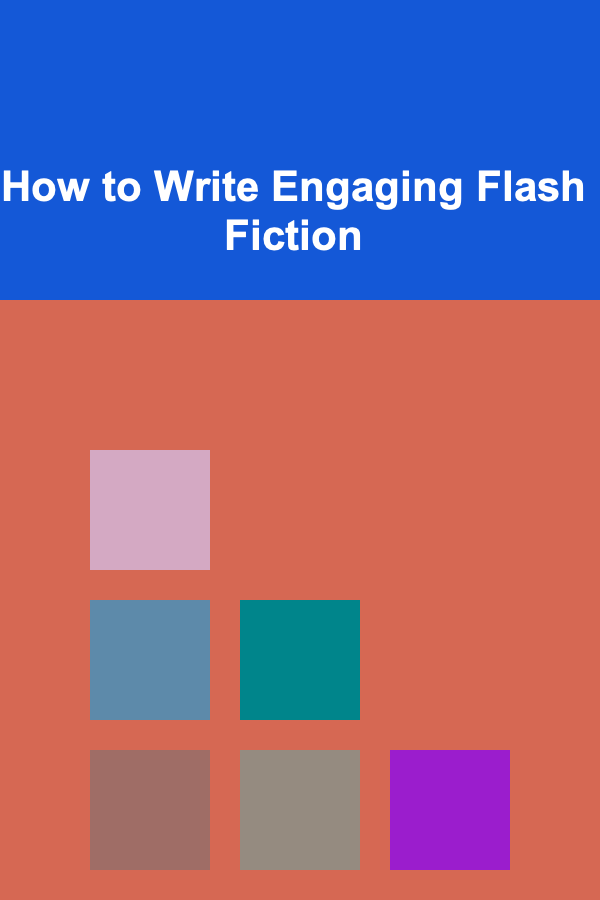
How to Write Engaging Flash Fiction
ebook include PDF & Audio bundle (Micro Guide)
$12.99$8.99
Limited Time Offer! Order within the next:

Flash fiction, a concise and impactful form of storytelling, has become an increasingly popular genre for writers looking to create meaningful narratives within a limited word count. Unlike longer stories that allow for intricate plot development, flash fiction focuses on brevity, with many stories typically ranging from 300 to 1,000 words. Writing flash fiction can be both an exciting challenge and an opportunity to experiment with language, character, and plot structure. In this article, we will explore the nuances of writing engaging flash fiction, offering tips and techniques to help you craft powerful short stories that leave a lasting impression.
The Power of Brevity: Why Flash Fiction Matters
Flash fiction is, at its core, a reaction against longer forms of storytelling. It offers readers a quick escape, immersing them in a complete narrative that delivers an emotional or intellectual punch in a short time. As our attention spans shrink and the demand for content becomes more immediate, flash fiction presents a unique opportunity to tell a full story within just a few pages.
The most powerful flash fiction stories distill the essence of longer works into a few carefully chosen words. These stories are typically precise, yet rich in meaning, leaving enough unsaid to provoke thought and discussion. The brevity of flash fiction forces writers to focus on what is truly essential to the narrative, cutting away excess details that may detract from the impact.
Focus on One Central Idea or Moment
Flash fiction's limited length means that you can't afford to explore multiple themes or subplots. Instead, you should focus on one central idea, conflict, or moment that serves as the heart of the story. Whether it's a life-changing decision, a moment of epiphany, or an emotionally charged encounter, the goal is to capture the essence of this moment in a way that resonates deeply with the reader.
How to Choose a Central Idea:
- Start with a strong emotion: Flash fiction often thrives on emotional intensity, so begin with a strong feeling like love, fear, anger, or regret.
- Focus on transformation: Choose a moment that captures a change in a character's life or worldview, making the story more impactful.
- Use a pivotal event: Instead of developing a lengthy narrative, focus on a single event that has significant meaning or consequence.
Creating Memorable Characters
Even within a tight word limit, flash fiction demands well-crafted characters. These characters don't need to be fully fleshed out, but they should feel authentic and evoke empathy from the reader. A memorable character in flash fiction is often defined by a single, powerful trait that drives their actions or decisions.
In many flash fiction pieces, character development happens quickly, but the most successful stories give readers enough insight into the character's motivations or desires to understand their choices. This can be achieved through subtle actions, dialogue, and the careful choice of words to describe the character's state of mind.
Tips for Developing Characters in Flash Fiction:
- Show, don't tell: Use specific actions, behaviors, and dialogue to show who the character is rather than describing them outright.
- Focus on conflict: The character should be involved in a conflict, either internal or external, that drives the story forward. Even small conflicts can be powerful when explored with depth.
- Keep it simple: Since there isn't much room for detailed backstories, focus on a single, defining characteristic or problem that makes the character stand out.
Crafting an Effective Plot
While flash fiction might not give you the luxury of a complex, multi-layered plot, it doesn't mean the plot has to be devoid of depth. The most successful flash fiction stories often focus on a single narrative arc that's compelling and meaningful. The key to writing an effective plot in flash fiction lies in its simplicity and its ability to evoke emotion or thought with a minimum of words.
Key Elements of a Flash Fiction Plot:
- Inciting Incident: Like any story, flash fiction needs a starting point. This could be an unexpected event, a decision, or a revelation that sets the plot in motion.
- Rising Action: Keep the action moving quickly. In flash fiction, you don't have time for long build-ups, so make the conflict feel immediate and pressing.
- Climax: Every story needs a turning point, where the conflict reaches its highest intensity. This is often where the character's journey culminates.
- Resolution: Flash fiction doesn't always need a neatly tied-up ending, but there should be some sense of closure, whether it's a revelation, a twist, or an open-ended conclusion that leaves readers thinking.
The Role of the Twist:
Many flash fiction stories feature an unexpected twist at the end. This twist doesn't have to be a complete plot reversal, but it should offer some kind of revelation that changes the way the reader views the story. A well-placed twist can elevate a simple narrative into something profound and memorable.
The Importance of Language and Style
In flash fiction, every word counts. The brevity of the form demands precision and economy in language. Writers must choose their words carefully to maximize impact without over-explaining or over-describing. The style of your writing should mirror the story's tone, whether it's suspenseful, poetic, or straightforward.
The best flash fiction uses language in a way that's both evocative and concise, creating an emotional resonance without unnecessary elaboration. Play with language to build mood, evoke sensory details, and bring your characters and setting to life in just a few words.
Tips for Writing Engaging Flash Fiction:
- Use strong imagery: Even within a small space, vivid imagery can make your story more immersive and memorable.
- Experiment with dialogue: Flash fiction doesn't have the room for lengthy conversations, but even a single line of dialogue can reveal a great deal about a character's personality and situation.
- Vary sentence length: Short, punchy sentences can create a sense of urgency or tension, while longer, flowing sentences can add depth and atmosphere.
The Role of Structure in Flash Fiction
Flash fiction doesn't have the luxury of a complex structure with multiple acts or scenes, but that doesn't mean structure is irrelevant. Even in a short story, the structure helps to guide the reader's experience and create a sense of progression.
While there is no one "right" structure for flash fiction, it's useful to think about how your story begins, develops, and ends. A strong flash fiction piece often employs a linear structure, but some writers experiment with fragmented or non-linear timelines. Regardless of the structure, the key is to ensure that each element serves the story's central theme or moment.
Tips for Structuring Flash Fiction:
- Begin in the middle of the action: Flash fiction benefits from starting at the heart of the conflict or event, allowing the reader to immediately engage with the story.
- Avoid unnecessary exposition: Since you have limited space, skip the lengthy explanations or introductions. Dive straight into the narrative.
- End with impact: Whether it's a resolution or a cliffhanger, the ending should leave the reader with something to think about. It should feel earned and meaningful.
The Editing Process: Refining Your Flash Fiction
Editing flash fiction can be even more challenging than writing it. Given the brevity of the form, every sentence must serve the purpose of the story, and there's little room for filler. After writing your first draft, it's essential to revise carefully, cutting unnecessary words, sentences, or paragraphs that don't contribute to the narrative's impact.
The editing process is where you can fine-tune your language, tighten the pacing, and ensure that your story's core message comes through clearly. Look for opportunities to enhance the emotional weight of the story and ensure that each word carries meaning.
Key Areas to Focus on During Editing:
- Conciseness: Eliminate redundant phrases or overly descriptive passages. Every word should have a purpose.
- Clarity: Even in a short story, it's essential that the plot and characters are clear. Don't leave the reader guessing about what's happening.
- Flow: Ensure that the story flows naturally, without any jarring transitions or confusing shifts in tone or perspective.
Reading Flash Fiction: A Tool for Improvement
One of the best ways to improve your flash fiction writing is by reading it. Reading other flash fiction stories allows you to see how other writers structure their stories, develop characters, and use language. It also helps you understand the various ways flash fiction can be written, from traditional narrative styles to more experimental approaches.
When reading flash fiction, pay attention to how the writer handles character development, tension, and pacing within such a short space. Take note of what works well and what doesn't, and consider how you can incorporate these lessons into your own writing.
Conclusion
Writing engaging flash fiction is an art form that demands skill, creativity, and discipline. By focusing on a central idea, creating compelling characters, and using language with precision, you can craft stories that resonate deeply with readers despite their brevity. Flash fiction offers writers the opportunity to experiment with different styles and structures, pushing the boundaries of storytelling in new and exciting ways.
As you develop your own flash fiction, remember that the most powerful stories often don't need many words---they simply need the right ones. Through careful editing, attention to detail, and a deep understanding of what makes a story truly impactful, you can create flash fiction that leaves a lasting impression long after the reader has finished the last sentence.

How to Ensure a Smooth Transition When Renting Out My House
Read More
How to Organize Your Wardrobe with Limited Closet Space
Read More
How to Prepare Financially for a Job Loss or Career Gap
Read More
How to Decorate Cakes with Fresh Flowers
Read More
How to Create Illustrated Maps
Read More
How to Create a Dentist Appointment To-Do List for a Stress-Free Visit
Read MoreOther Products

How to Ensure a Smooth Transition When Renting Out My House
Read More
How to Organize Your Wardrobe with Limited Closet Space
Read More
How to Prepare Financially for a Job Loss or Career Gap
Read More
How to Decorate Cakes with Fresh Flowers
Read More
How to Create Illustrated Maps
Read More